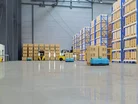The advantages & disadvantages of automated guided vehicles

Luke Goodwin is an experienced content marketing manager with a demonstrated history of working in the logistics and supply chain industry. Currently, he works at FlexQube where he creates valuable content relevant to the intralogistics and material handling industries. Here, he tells Manufacturing about the pros and cons of using automated guided vehicles.
Many manufacturing and warehousing floors are turning into technologies such as robotics to automate and modernise their operations. For example, automated guided vehicles systems (AGVs) are often used for transporting heavy materials on the plant floor.
Automated Guided Vehicles are driverless vehicles that follow fixed routes on the plant floor. Therefore, it is essential to evaluate whether AGVs are the best fit for your plant’s floor. Keep reading to understand the pros and cons of AGVs.
Pros of Using Automated Guided Vehicles
-
Enhanced Plant Floor Safety
AGVs eliminate the human element in transporting materials and goods on the plant floor. As a result, AGVs can handle hazardous tasks such as working in extreme temperatures, handling dangerous substances, and transporting heavy materials.
These driverless vehicles also operate at monitored speeds with consistent and smooth acceleration or deceleration. AGVs controlled operations are in contrast with manual forklifts, which operate at different speeds and can endanger workers. Therefore, AGVs play a crucial role in enhancing safety on the plant floor.
-
Reduced Damage on Materials and Structures
Human workers are prone to errors, especially when distracted or tired. For example, a human worker may fail to see an obstacle and eventually ram into it. Such human errors may cause damage to the floor structures or materials.
AGVs don’t get tired or distracted, reducing the chances of ramming into obstacles. These robots use cameras, sensors, and lasers to detect obstacles and stop, avoiding a collision.
-
Increased Inventory Accuracy and Efficiency
Tracking inventory is essential on any plant floor, and AGVs can offer quality materials handling. Floor managers can link AGVs systems with warehouse management systems or control systems and automatically track inventory.
Such system integration will lower costs associated with inventory management. In addition, it will result in increased accuracy and efficiency, letting managers know exactly how much materials and finished goods they have.
Image source: FlexQube
Cons of Using Automated Guided Vehicles
-
High Installation Costs
One of the biggest challenges of installing AGVs is the high cost of deploying this new technology. In addition to the cost of the AGV itself, you will need to install a guidance system on the floor.
Other installation costs associated with AGVs include handling and maintenance personnel training costs. Furthermore, the entire cost will depend on several factors, such as the number of AGVs, the plant floor size, and the software the AGV will use.
-
Limited Flexibility
The main disadvantage of AGVs is their limited flexibility. The limited flexibility in AGVs makes them ideal for repetitive tasks. These robots follow fixed routes that are integrated on the plant floor.
Unlike human beings or autonomous mobile robots, which react and change their tasks or adjust their speed, AGVs cannot. Therefore, AGVs are not suitable for floor operations that require some level of flexibility, such as picking tasks.
-
Restrictive Floor Requirements
AGVs need particular work environments to work well. Therefore, factors that would not affect the performance of a manual forklift will affect the performance of an AGV.
Floor flatness and levelness need to be considered before installing an AGV. In addition, the transition from one surface to another or between different heights may be a challenge.
Too many vibrations on the floor may also cause a malfunction on the electronic devices and connectors. As a result, many plant floors will need improvement before installing AGVs.
Conclusion
While AGVs play a crucial role in automating a plant floor, floor managers must take careful consideration to ensure that they are the best fit. Therefore, it is essential to understand the benefits and drawbacks of the AGV before beginning the installation process.
- Digitalisation as a Strategy to Attract and Retain WorkersDigital Factory
- UPDATED VENUE & DATE – Manufacturing LIVE Chicago 2025Sustainability & ESG
- ABB Cuts Industrial E-Waste in Quest for CircularitySustainability & ESG
- Why Are Manufacturers Doubling Down On Digital Twins?Digital Factory

